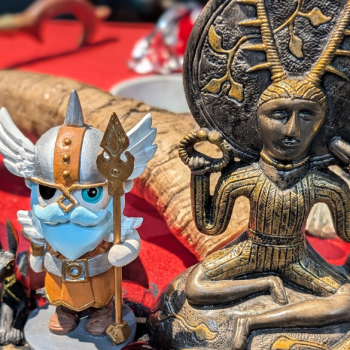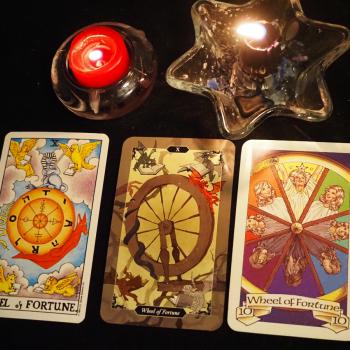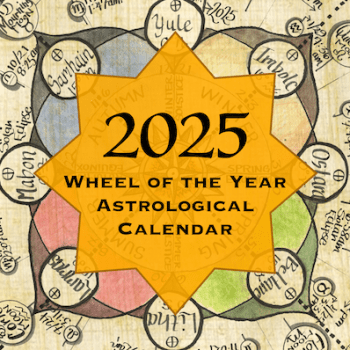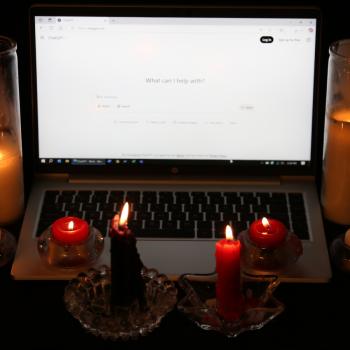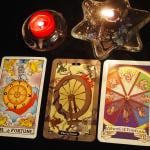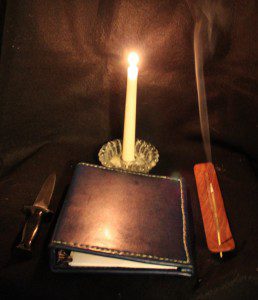 Figuring out where religion ends and magic begins is only slightly less complicated than figuring out where religion ends and politics begins. Religion and magic both deal with things that are generally considered supernatural. I argue that much of what is considered supernatural is simply an inadequate understanding of the natural world that gives too much weight to atheistic materialism, but that’s another rant for another day.
Figuring out where religion ends and magic begins is only slightly less complicated than figuring out where religion ends and politics begins. Religion and magic both deal with things that are generally considered supernatural. I argue that much of what is considered supernatural is simply an inadequate understanding of the natural world that gives too much weight to atheistic materialism, but that’s another rant for another day.
Aleister Crowley’s classic definition of magic is “the science and art of causing change to occur in conformity with will.” Using that definition (or pretty much any other common definition), most religions are full of magic.
Judaism has the Passover story of blood over the doorposts and Moses parting the Red Sea. Christianity has the miracles of Jesus and the apostles, transubstantiation, and the forgiveness of sins. We don’t know much about ancient Druidry, but there are numerous references to Druid magic in the historic and literary records, including shapeshifting. Even the non-theistic versions of Buddhism have the changes in consciousness produced by mindfulness and meditation.
But religion has always had an uneasy relationship with magic. Religion (from the Latin religare: “to bind together”) is largely a group thing – common beliefs and common practices maintain social order and good relationships with the Gods and spirits. Magic is powerful – individuals may use it to put personal gain above the common good, to harm those who have wronged or slighted them, or just to subvert authority. Most of us know the Old Testament prescribes death for the malicious use of magic, but so did Roman law. Even today, there are places in the world where those suspected of witchcraft are regularly killed.
Despite these concerns, most religions have a tradition of magic within them. Sometimes especially holy people are considered “safe” to study magic. More frequently, ordinary people just do it because they have a need for it.
So, what is – or what should be – magic’s place in our contemporary polytheist religions and traditions?
Some polytheists ignore magic, preferring to focus on devotion to the Gods, ancestors, and spirits. Some think magic is an impious attempt to usurp power that rightfully belongs to the Gods.
I came to polytheism through the modern Pagan movement, with its strong emphasis on magic and witchcraft. Having learned a few things along the way, I’m not inclined to give them up. Every other religion has a tradition of magic within it, whether that tradition is official, unacknowledged, or actively opposed by orthodox leadership. And given the general decline of the wider world, our need for magic grows stronger every day.
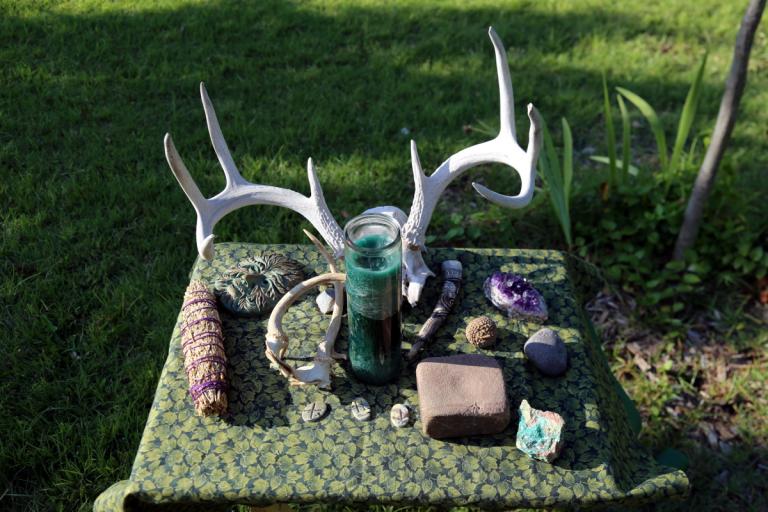 So I say magic is part of our heritage – let’s embrace it. Let’s study it, learn it, practice it, and teach it. Let’s incorporate it into our private practices and our group workings. Let’s incorporate it into our public rituals and celebrations, at least to the extent we can do so responsibly. Those old fears of witchcraft aren’t entirely unfounded – some people can’t be trusted with magic. And some people can’t or don’t want to deal with the risks involved in serious magic. But magic is part of our legacy, and we do ourselves no favors if we reject it.
So I say magic is part of our heritage – let’s embrace it. Let’s study it, learn it, practice it, and teach it. Let’s incorporate it into our private practices and our group workings. Let’s incorporate it into our public rituals and celebrations, at least to the extent we can do so responsibly. Those old fears of witchcraft aren’t entirely unfounded – some people can’t be trusted with magic. And some people can’t or don’t want to deal with the risks involved in serious magic. But magic is part of our legacy, and we do ourselves no favors if we reject it.
Each polytheist religion and each individual polytheist must make their own decision as to the place of magic in their tradition and practice. But the polytheism I practice, teach, and advocate for includes magic.
What kind of magic, you ask? While I’m not a chaos magician, I take a very chaos magic approach to that question: the kind of magic that works. There are four basic categories of magic I work with.
Theurgy (“God – working”) is magic done through or with the assistance of divine beings. Sometimes this is a simple as intercessory prayer – asking a deity for a blessing or assistance. More frequently it involves invoking or meditating on a God or spirit in order to absorb some of Their divine essence and become more God-like yourself. This is a worthy goal and there are numerous groups and traditions that teach this practice, many that are part of the Western Mystery Tradition.
However, some of what is often called theurgy would be better described as applied psychology. While I do not want to reopen that can of worms, I do want to point out that polytheism is the religious regard for many real Gods. Polytheist theurgy is grounded in respectful reciprocal relationships, not on discovering your true self (which is a good and necessary goal, but it’s not theurgy and it’s not polytheism).
Energy magic is the psychic manipulation of power for everything from grounding and centering to shielding to stopping a Nazi invasion. Sometimes it involves drawing power up from the Earth and down from the Sky, as with the ADF Two Powers meditation. Other times it involves raising power through dancing, chanting, drumming, or other activities, and then releasing it toward a target, as in a typical Wiccan ritual.
Energy magic is simple and intuitive, in large part because of its many parallels in fiction and popular culture. Don’t expect to ever see sparks shooting from your fingertips, but do the work and you can feel the energy moving through you.
Some have criticized energy magic’s authenticity, claiming it was unheard of prior to the early 20th century… which, coincidentally, was when electricity and radio became commonplace. That may be true (it strikes me as likely, though my knowledge of magical history isn’t strong enough to say for sure), but I’ve used it successfully enough times that its origin isn’t really important any more. It works – that’s all that matters.

Traditional witchcraft is quite popular these days and its exact boundaries are rather unclear. Here I’m referring to home remedies, dowsing, poppets, candle magic, herb magic, and general kitchen witchery. Call it rootwork, call it hoodoo – it’s the magic of the cunning men and women of Britain and Ireland and their Appalachian relatives.
It is largely (but not entirely) sympathetic magic based on associations and correspondences (“this is like that, therefore this will influence that”). It is secular in nature, but it’s frequently wrapped up in Christian references and imagery – because the people practicing it have been Christians.
Want a good introduction? Pick up one of Byron Ballard’s books, or catch her classes at one of the Pagan gatherings where she’s teaching.
Sigil magic is my favorite tool for magical workings. It’s the graphical process of writing your goal, converting it from an English (or your language of choice) sentence into a visual glyph, activating the sigil, then letting it go. It’s simple, straightforward, and effective. This 2012 Rune Soup blog post from Gordon White tells you everything you need to know about what sigil magic is, why it works, and how to use it. If you want more, get Gordon’s book The Chaos Protocols.
I’m an engineer with an insatiable curiosity – I want to know how things work. I have a few thoughts on the matter, but they’re more “mostly plausible hypotheses” than fully developed theories. Our attempts to develop good, robust theories of magic are hampered by the materialist assumptions of our mainstream society. We’re going to have to deepen our understanding and acceptance of animism and the spirit world before we can make much progress on theories of magic. Or at least I am.
Other than theurgy, these forms of magic have little if anything to do with the religious regard for many real Gods. They aren’t part of polytheism, much less a requirement of it. But magic has been a part of religion since the beginnings of religion, and it is part of the polytheist religion I practice. Magic is our legacy, one we would do well to reclaim and relearn.





